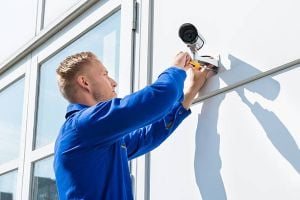Keeping our homes safe is important, right? Professional installation can cost a bit, so the question is: can you install CCTV cameras yourself? The answer is yes! And in this article, we’ll show you how to install CCTV cameras on your own, step by step.
This guide will help you set up your own CCTV system without calling the pros. Ready to save some cash and do it yourself? Let’s go!


Editor
Mae An NG chevron_right
Table of Contents
Why Go DIY for Your CCTV?
- Save Money: Professionals charge for their time and skill. If you do it yourself, you only pay for the camera kit.
- You're the Boss: You decide exactly where each camera goes. You know your home best.
- Learn Something New: Feel a bit like a tech hero when you're done. Plus, you'll understand your security system inside out.
- Privacy Control: You're in charge of your footage and where it's stored, especially if you choose a system with local storage.
Can You Really Do It Yourself?
Ask yourself these questions before you buy what you need.
- Are you okay with basic tools? We're talking about a drill, screwdrivers, maybe a ladder. Nothing too crazy.
- Got a bit of patience? It might take a few hours, especially on your first time.
- Comfortable with heights? Some cameras need to be mounted up high for a good view.
- Basic tech-savvy? You'll need to connect the cameras to your Wi-Fi and set up an app on your phone. Usually, it's quite straightforward.
If you answered "yes" or "can try" to most of these, then DIY CCTV installation is definitely possible for you!
Your Simple Guide - How to Install CCTV Cameras

Installing a CCTV camera system doesn’t have to be complicated or expensive. Here’s a simple guide on how to install CCTV cameras at home or your shop:
Choose the Right Spot for Your CCTV Camera
Before you start drilling holes, take a few minutes to plan. The location of your CCTV camera is super important because it affects how much area you can monitor.
Best Spots to Install CCTV Cameras:
- Front Gate: So you can see who enters your home compound.
- Main Door: Catch clear footage of visitors or potential intruders.
- Driveway or Car Porch: Keep an eye on your car and front yard.
- Backyard or Side Entrance: These are common entry points for burglars.
- Near Windows: Especially if they’re not grilled or easily accessible.
Pro Tip: Avoid placing cameras too low — people might tamper with them. Mount them at least 8 feet high and tilt them downward for the best angle. Also, avoid direct sunlight or lights that can blur night vision.
Mount the CCTV Camera Properly
Once you’ve picked the ideal location, it’s time to physically install your camera.
What You'll Need:
- Drill and wall plugs
- Screws
- Screwdriver
- Ladder
Carefully drill holes into the wall or ceiling, insert wall plugs, and secure the camera using screws. Most CCTV units come with mounting kits, so make sure you follow the instruction manual. Adjust the angle before tightening everything up.
Safety Reminder: If you're working on high areas, use a stable ladder and get someone to help you hold it.
Run the CCTV Cables (For Wired Systems)
If you're using a wired CCTV camera, you’ll need to run cables from the camera back to the DVR (Digital Video Recorder) or NVR (Network Video Recorder). Wireless cameras don’t need video cables, but they still need power cables (unless battery-powered).
Tips for Cable Management:
- Use cable clips or trunking to secure the wires neatly along walls.
- Avoid placing cables where people might trip over them.
- Keep wires hidden or out of reach to prevent tampering.
- Avoid placing cables near high-voltage appliances to prevent interference.
Pro Tip: Plan your cable path before drilling holes through walls or ceilings. It’ll save you a lot of headache.
Connect Everything to the CCTV System
Now that your cameras are mounted and cables are in place, it’s time to connect everything.
Here's what you should do:
- Plug the camera’s video cable into the DVR or NVR.
- Connect the power adapter to your camera and plug it into a power source.
- Connect your DVR/NVR to a monitor or TV using an HDMI or VGA cable.
- For wireless systems, follow the app or software guide to pair your camera with your network.
Local Tip: Use a surge protector when plugging into the wall. Here in Malaysia, power surges during thunderstorms can damage electronics.
Set Up and Test Your CCTV Camera System
You’re almost done! Turn on the DVR/NVR system and check your camera feeds.
Don’t Forget:
- Adjust the camera angles if needed.
- Fine-tune the focus and clarity.
- Set up your recording settings — continuous, motion-detect, or scheduled.
- Enable remote viewing on your smartphone using the official CCTV app (most brands support this).
Make sure your system is password-protected and update the firmware regularly for better security.
Bonus Tip: If your camera supports SD cards, you can back up video footage locally even if the DVR fails.
Extra Tips for Us!
- Weather-Proofing is a MUST: If your cameras are outdoors, make sure they are at least IP65 rated for weather resistance.
- Watch Out for Geckos and Insects: Sometimes, these little critters can crawl over lenses or trigger motion detection. Clean your lenses regularly.
- Power Stability: We sometimes get power trips (blackouts). Consider a UPS (Uninterruptible Power Supply) for your DVR/NVR and router to keep things running for a bit if the power goes out.
- Internet Plan: For good quality streaming and remote viewing, make sure your home internet (like Unifi, Maxis Fibre) is stable and has a decent upload speed.
- Be a Good Neighbour: Don't point your cameras directly into your neighbour's house or private areas.
When is DIY NOT a Good Idea?
- Very Large Houses or Complex Layouts: If you have a huge bungalow with many blind spots, planning and wiring can become a nightmare.
- You Need Super Advanced Features: Things like pan-tilt-zoom (PTZ) across many cameras, or integration with sophisticated alarm systems, might be better left to pros.
- You're Really Not Confident/No Time: If the thought of drilling holes fills you with dread, or you just don't have a free weekend, then calling a professional is perfectly fine.
- Condo/Apartment Rules: Some high-rise buildings have strict rules about drilling or installing things on the exterior. Always check with your management office first!
Final Thought

Installing a CCTV system by yourself is totally doable — and it’s a smart move for any home or business owner. Just take your time, follow the steps, and always prioritize safety when handling tools or climbing ladders.
If you’re not confident doing it yourself, there are plenty of affordable CCTV installation services in Malaysia that can help you out. But if you're a DIY type, this guide should be all you need to get started.
